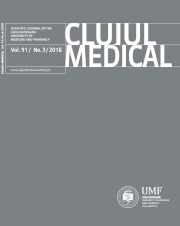Incidental findings during follow-up scans in oncological patients
DOI:
https://doi.org/10.15386/cjmed-931Keywords:
pulmonary embolism, cancer, contrast-enhanced computed tomography, follow-upAbstract
Background and aim. To assess the prevalence of incidental findings during follow-up scans of patients with oncologic pathology.
Methods. 499 follow-up scans from different patients with cancer pathology were retrospectively analyzed. Findings which were not suspected by the clinician or known from previous scans were considered as incidental lesions. We excluded lesions that were already suspected by the clinician or were already recorded in the patient’s history before the initial computed tomography (CT) scan. The CT scans were performed on two different machines (“Siemens Somatom Sensation, 64 slices, Erlangen, Germany” and “Siemens Somatom Emotion, 16 slices, Erlangen, Germany”).
Most of the patients had a native scan followed by a thoraco-abdominal-pelvic image acquisition after the injection of intravenous contrast media.
Results. 28% of the patients had unsuspected incidental findings. The prevalence of incidental findings was similar: 56.6% of them were found in men and 43.4% in female patients. In 6 cases (1.2%) the presence of unsuspected pulmonary embolism was discovered. From these cases, 5 (83.3%) had metastatic disease at the moment of the follow-up CT scan and 1 (16.6%) had metastasis-free disease. In 17 patients out of 499 (3.4%) we incidentally made an important discovery which either changed the cancer therapy or required immediate treatment.
Conclusion. Incidental findings are not rare in oncological patients and the radiologist has to be aware of their presence in order not to overlook them and to correctly diagnose them.
Downloads
Additional Files
Published
How to Cite
Issue
Section
License
The authors are required to transfer the copyright of the published paper to the journal. This is done by agreeing to sign the Copyright Assignment Form. Whenever the case, authors are also required to send permissions to reproduce material (such as illustrations) from the copyright holder.

The papers published in the journal are licensed under a Creative Commons Attribution-NonCommercial-NoDerivatives 4.0 International License.

